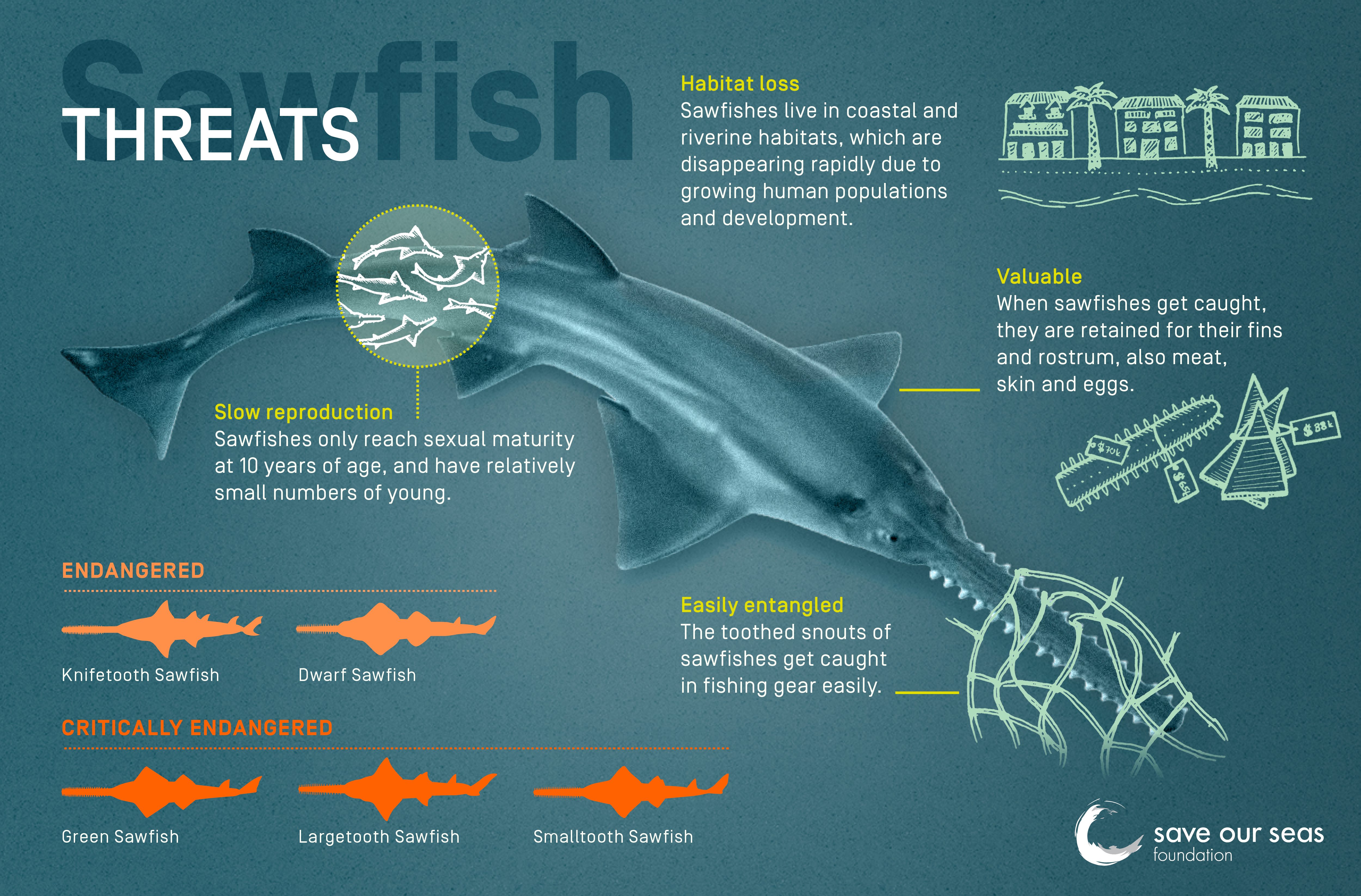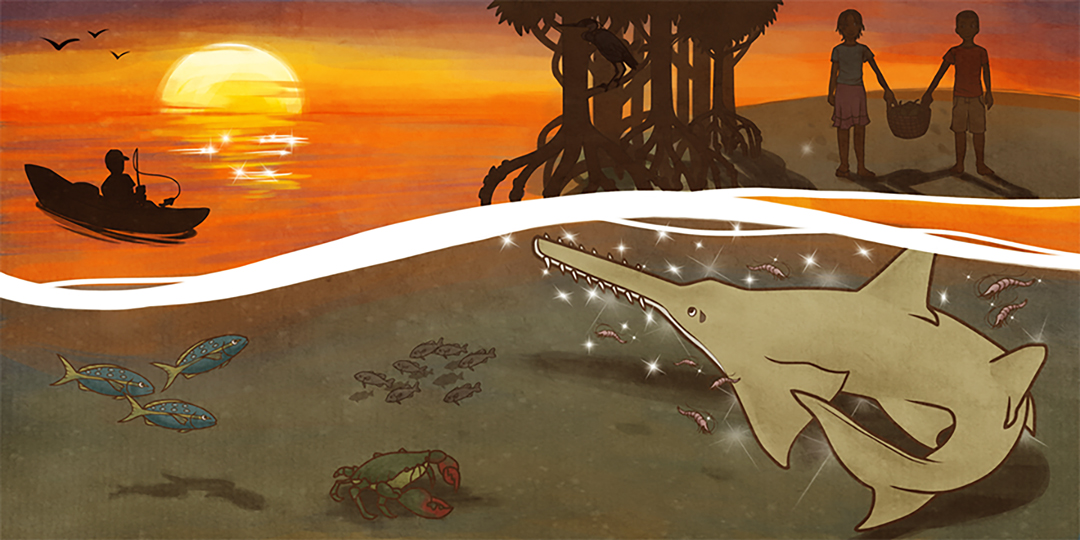Sawfish Threats
17 October 2017 marked the first annual International Sawfish Day, dedicated to increasing knowledge and awareness of sawfish throughout the globe (follow along on social media #IntlSawfishDay). In celebration of this initiative, SOSF has rolled out five informative and educational web articles about one of the ocean’s most critically endangered groups of elasmobranchs. Topics included; Sawfish Biology, Sawfish Habitats, Cultural Significance of Sawfish, Sawfish Threats, and Sawfish Conservation.

Illustration by Jessica Berliner | © Save Our Seas Foundation
What makes sawfish vulnerable?
Today, all five species of sawfish are listed as either endangered or critically endangered by the International Union for Conservation of Nature (IUCN). A 2014 study published by researchers from the Shark Specialist Group of the IUCN found that out of all types of sharks, skates and rays, these five species of sawfish face the greatest risk of extinction.
Fishing has played a significant role in sawfish population declines worldwide. This is because their most remarkable adaptation, the saw-like rostrum (used to detect and stun prey) is highly susceptible to entanglement in fishing gear. In particular, gill nets and trawlers have caused high amounts of bycatch and mortality on sawfish.
Habitat loss has also caused massive declines in sawfish populations worldwide. Sawfish depend on coastal and riverine habitats, which are disappearing rapidly due to growing human populations and development. On top of this, sawfish only give birth to a small number of pups and cannot reproduce until they reach about 10 years in age. This worsens the threat of overexploitation.
Juvenile sawfish also depend on mangroves (coastal vegetation) to protect themselves from predators. Unfortunately, many mangrove habitats have been destroyed in places where young sawfish are born.

A Smalltooth Sawfish entangled in fishing gear off the coast of Florida. Photo © Michael Patrick O'Neill
Barriers to research and conservation efforts also a major threat
Aside from the often discussed challenges sawfish face, SOSF Project Leader, Ruth Leeney believes that additional factors, such as the barriers researchers and conservationists working on this family of fish come in contact with, also threaten sawfish population numbers.
Ruth has been studying sawfish for more than five years in many places across the globe. During this time, her work has addressed a lack of up-to-date information on where sawfish populations still exist. This scarcity of data is a hurdle for developing effective conservation strategies.
‘The current distribution range of sawfishes is certainly a shadow of what it was several decades ago,’ said Ruth. ‘For significant parts of their former range, basic up-to-date information on the persistence of sawfish populations is lacking.’
According to Ruth, effective management and conservation strategies designed to solve the threats these creatures face cannot be put in place unless a larger amount of relevant data is obtained.
Thankfully, a number of groups and projects are now tackling this challenge (explore SOSF’s 11 sawfish research and conservation projects here).
Education in the developing world a significant factor
Another, far greater challenge that is threatening remaining sawfish populations is the locations in which they are found.
‘Invariably, these animals will be located in developing countries, most likely in rural, hard-to-reach areas which are difficult to monitor,” Ruth explained. “In such areas, human communities are often hugely reliant on fisheries in freshwater and coastal habitats as a means of survival. Anything a fisher catches is used as food or as a saleable commodity.’
Ruth believes that for sawfishes to be effectively protected in these locations, the conservation and management plans must take the needs of nearby human communities into consideration, and must involve them in the process of developing the plan.
‘Alternative ways for community members to produce food or earn money may need to be developed,’ she said. ‘This way, these communities will be less reliant on fishing, thereby removing the primary threat to sawfishes everywhere — the ubiquity of fishing nets.’
In terms of next steps, Ruth believes that raising awareness about the importance of having healthy and diverse seas and rivers is crucial.
‘My hope is that through education of communities and by listening to their concerns and needs, we can create a sense of stewardship for sawfishes, and an understanding of the need for top predators as part of healthy marine and freshwater ecosystems.’
Ruth has created a short educational book on sawfishes and ecosystem balance, designed with rural fishing communities in the developing world in mind.

The final illustration in Ruth's educational book, 'The King of the Fishes', which illustrates her wish for a happy ending for sawfishes. Image © Jen Richards and Ruth Leeny
However, education alone is not enough, especially if the conditions in which people live offer them no choice but to catch and kill sawfish if the opportunity arises.
‘In some parts of Africa, sawfish populations seem to persist only in rural areas where human populations are totally reliant on fisheries for survival,’ Ruth explained. ‘Ultimately, the protection of sawfishes in these areas will only work if we can alleviate the poverty facing communities, thereby reducing their dependence on marine and freshwater wildlife as their sole source of food and income.’
‘That is of course a huge task,’ Ruth concluded. ‘But, wherever it succeeds, it will benefit not only sawfishes but also entire coastal, mangrove and river ecosystems, and the people whose lives are so closely intertwined with those habitats.’
To learn more about Ruth’s research, check out her project page here.
